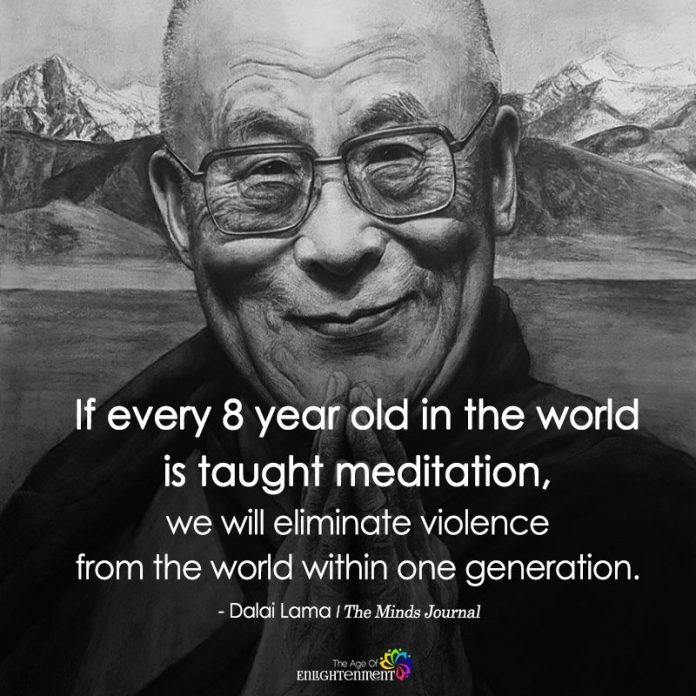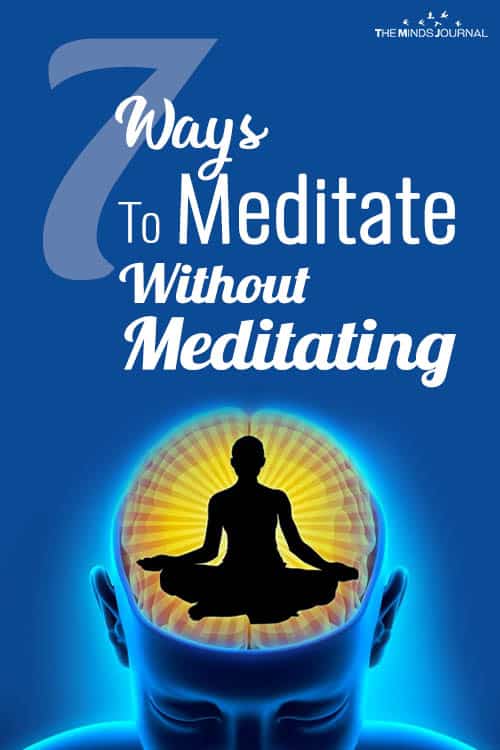You’ve heard about mindfulness. You know meditation is good for you. You know it can help you de-stress and calm your mind. And so you’ve tried to meditate and failed miserably. That’s nothing to be ashamed of. Been there, done that.
Meditation is a practice that takes time and patience. So can we meditate without sitting still? Are there any non-traditional meditation practices? There are. If you’re wondering how to meditate without actually meditating, you’ve come to the right place.
The problem with meditation
If you’re reading this, then it means you want to meditate. But sitting silently with yourself without any distractions is not easy for most of us. I have been meditating, on and off, for a while now and I have personally struggled with getting used to it, especially during the initial phase. I had to wrestle to develop a regular habit of setting time aside, sitting down, relaxing my mind and body, and simply focusing on my breath. It can be really hard to get to this point.
The moment you sit still and close your eyes, a thousand thoughts and emotions rush in. Sometimes you find yourself lost in those thoughts while others times you feel uncomfortable with them and don’t really know what to do. It is hard to sit down with yourself and confront your thoughts and emotions like this. You fidget. You get distracted. You say to yourself, “Do I really have to do this?”
You feel you’re not doing it right. You wonder how long it’s been. You question why your mind is not calming down. And eventually, you lose patience and give up. But even then, even when you think your attempt at meditating was a failure, you experience a glimpse of inner peace. And that is why you got hooked. That is why you want to know how to meditate without actually going through the uncomfortable part of sitting down with yourself.
Related: Meditation For Beginners: Everything You Need To Know About Meditation
Non-traditional meditation techniques
Lucky for you, there are different ways you can practice mindfulness through informal meditative practices and these are often as effective as the real thing. Informal meditation and mindfulness practices are easier as you simply need to bring your awareness to your present experience through daily activities. According to a Psychology Today article by psychologist and author Karen Kissel Wegela, Ph.D. –
“These are the everyday activities of life that can support the cultivation of mindfulness. When we engage in these activities, especially if we are willing to let go of distractions like listening to an iPod or playing the car radio, they give us the chance to tune into what is happening right now. We can pay attention to our sense perceptions, our emotions, and our thoughts.”
How to meditate and be mindful in non-traditional ways
Here are simple and effective ways to be more mindful and practice meditation through daily activities without sitting still or chanting prayers.
1. Get more sleep
Sleep is an excellent meditation practice as it helps to rest our conscious minds. When you sleep, your subconscious mind becomes more active. It sifts down all the stress and anxiety that your conscious mind was unable to sort throughout the day. Sleep also helps your mind refresh itself and gives you mental and physical energy to start another day with better mental strength.
The fact is, situations can often be too stressful for our conscious mind to deal with it. Hence, our thoughts and emotions get suppressed as we try to deny, overlook or ignore them. When we sleep, the subconscious mind deals with these difficult emotions and helps to reduce stress in our daily lives. Sleep is an inherent part of our lives and now you have more reason to fall asleep.
2. Exercise with awareness
By exercising I don’t necessarily mean hitting the gym and getting your pump on. Although that might be a good idea depending on your preference, simple exercises like running, swimming, taking a walk, dancing, or practicing yoga can be an excellent informal way to experience mindfulness meditation.
Any form of physical activity can feel meditative when you bring your focus and awareness into the subtle movements of your body. Exercise is an active meditation that can make you feel calm and relaxed as long as you engage all your senses in the activity. However, you need to make sure your breathing is synchronized with your body movements.
Related: Sufi Whirling Meditation: What Is This Mystical Practice And How You Can Do It
3. Connect with animals
Spending time with our furry friends can be an exceptionally calming and relaxing activity, especially when you are engaging in it mindfully. When you are aware of the bond that you share with your pet or any animal, you feel an instinctive emotion through this pure and uncorrupted emotional connection. Being and playing with animals makes us feel happier and elevates our mood by releasing feel-good endorphins.
Studies on psychosocial and psychophysiological effects of human-animal connections have found that playing with our pets can actually bring a notable difference in our moods. It also helps to significantly reduce the level of the hormone cortisol which leads to stress. Animal time also helps in the increased production of serotonin which makes us feel better and happier.
4. Get creative
If you want to know how to meditate without actually going through the traditional process, then you should start with making some art. Creativity allows us to express our innermost emotions and thoughts. Creating art allows you to release all your pent-up feelings and express yourself in a relieving yet satisfying way.
However, art simply doesn’t mean illustrating, painting, or sculpting. It can be anything that allows you to express yourself. It can be writing down your thoughts or writing fiction, photography, sewing, putting your makeup on, making creative videos, or even memes. It can be absolutely anything that gets your creative juices flowing.
Creativity enables you to tap into the universe and connect directly with our source of energy. This helps to feed our souls and rise above the normal, materialistic world. Creating art is a form of active meditation and is highly relaxing.
5. Cook mindfully
Cook what you love with full attention and from your heart. Food nourishes our mind and body and mindful cooking is an excellent alternate meditation practice. Something as simple as cooking or baking can be your daily meditation ritual.
Instead of ordering food online or just cooking for the sake of eating, experience every moment and mindfully connect with the process of cooking. You can cook anything you want as long as you’re conscious about every stage of the cooking process. By bringing love and presence into your cooking you can turn it into a comforting meditation treat.

6. Do stargazing
The universe is fascinating and the night sky can be magical and mesmerizing. When you look at the stars and detach from the world, you engage with the universe and connect with yourself.
Stargazing can be the most soothing way to be present in the current moment. Observe what you see, hear, taste, smell, and feel. Scan your body and be aware of your senses without getting attached or judging them. This is how to meditate to feel peace and serenity inside you.
7. Just breathe
One of the core elements of all traditional meditation practices is the breath. Although it may sound too easy, breathing with awareness takes a little bit of practice and is a highly effective mindfulness practice. By focusing on, connecting to, and becoming aware of our breath, you can completely relax your mind and body, regardless of where you are or what you’re doing. It is the easiest way to meditate without sitting down to meditate.
Breathing mindfully gives you an opportunity to meditate anytime you want and become aware of the present moment. Breathing with awareness enables you to live life and deal with different situations in a more responsive and calmer way. Breathing is the simplest form of meditation.
Related: 7 Daily Habits To Help You Practice Mindfulness Effectively
Why you should meditate
Meditation helps. I have personally experienced a lot of benefits after struggling through anxiety and depression for years. But don’t take my word for it. A recent study by Johns Hopkins University has found that meditation helps to reduce symptoms of stress, anxiety, and depression in adults. It was found that meditation has the same effect size as antidepressants.
Another study has revealed that meditating for more than 8 weeks can modify genes that manage glucose metabolism, circadian rhythms, and inflammation which in turn leads to reduced blood pressure. One study also found that mindfulness meditation has “salutary effects on patients having clinical depressive disorders during the acute and sub-acute phases of treatment.”
Just a few weeks of meditation can also help to improve sustained attention and focus for extended periods of time, confirmed another study. Moreover, long-term meditation practices also have potential age-defying effects on gray matter atrophy and can help the human brain to stay younger, recent research found.
The list of benefits that meditation offers is endless as more new research is being conducted to find out how mindfulness and meditation can help a live a healthier life. The question here is not why you should meditate, rather how to meditate without facing typical problems and issues related to meditation for beginners.

Meditation without meditating is easy
Meditation takes a lot of patience and effort to master, whether it’s a conventional or informal technique. The techniques I mentioned above are most certainly easy and effective, however, it may take some time and practice for you to do your daily activities with mindfulness. Meditating without actually meditating is a great way to get started as it is convenient and efficient.
Related: How To Find Happiness By Living In The Present Moment
The essence of meditation is awareness. The moment you can conduct your daily activities with awareness, you are in meditation.











Leave a Reply